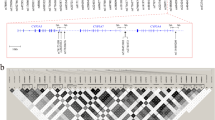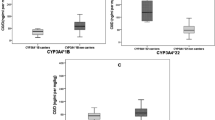Abstract
The P450 oxidoreductase (POR) and peroxisome proliferator-activated receptor alpha (PPARA) genes are associated with the activity of cytochrome P450 enzymes in vivo. We aimed to investigate the impact of single nucleotide polymorphisms (SNPs) in the POR and PPARA genes on the pharmacokinetics of tacrolimus (TAC) in renal transplant recipients. A total of 220 recipients were assessed and 105 recipients were included for final quantitative analysis. Blood samples were collected and DNA was extracted. Targeting sequencing based on next-generation sequencing was applied to detect the SNPs in the POR and PPARA genes. In addition, a systematic review and meta-analysis was performed to comprehensively evaluate the influence of POR and PPARA mutations on the TAC concentrations. A total of 81 SNPs were obtained. Three SNPs (POR*28, Chr7:75619677 and Chr7:75614288) were found to be significantly associated with the TAC pharmacokinetics at 3 months, 6 months, and more than 12 months. No significant association was observed in the combined effect analysis of CYP3A4*1G and CYP3A5*3 with three significant SNPs in the POR gene. Age, post-transplant duration, and the use of sirolimus were identified as the most important factors that influenced the TAC concentrations. A meta-analysis of four studies results and our cohort indicated that compared with recipients carrying the CT or TT genotypes, recipients carrying the CC genotypes of POR*28 showed significantly higher TAC concentrations. Our study suggested the positive influence of mutations in the POR gene on TAC exposure at 3 months after kidney transplantation.
This is a preview of subscription content, access via your institution
Access options
Subscribe to this journal
Receive 6 print issues and online access
$259.00 per year
only $43.17 per issue
Buy this article
- Purchase on Springer Link
- Instant access to full article PDF
Prices may be subject to local taxes which are calculated during checkout



Similar content being viewed by others
References
Rodriguez-Peralvarez M, Germani G, Darius T, Lerut J, Tsochatzis E, Burroughs AK. Tacrolimus trough levels, rejection and renal impairment in liver transplantation: a systematic review and meta-analysis. Am J Transplant. 2012;12:2797–814.
Piotti G, Cremaschi E, Maggiore U. Once-daily prolonged-release tacrolimus formulations for kidney transplantation: what the nephrologist needs to know. J Nephrol. 2017;30:53–61.
Caillard S, Moulin B, Buron F, Mariat C, Audard V, Grimbert P, et al. Advagraf((R)), a once-daily prolonged release tacrolimus formulation, in kidney transplantation: literature review and guidelines from a panel of experts. Transplant Int. 2016;29:860–9.
Chen YH, Zheng KL, Chen LZ, Dai YP, Fei JG, Qiu J, et al. Clinical pharmacokinetics of tacrolimus after the first oral administration in combination with mycophenolate mofetil and prednisone in Chinese renal transplant recipients. Transplant Proc. 2005;37:4246–50.
Li CJ, Li L. Tacrolimus in preventing transplant rejection in Chinese patients--optimizing use. Drug Des Devel Ther. 2015;9:473–85.
Kuypers DR. Immunosuppressive drug monitoring - what to use in clinical practice today to improve renal graft outcome. Transplant Int. 2005;18:140–50.
Elens L, Bouamar R, Shuker N, Hesselink DA, van Gelder T, van Schaik RH. Clinical implementation of pharmacogenetics in kidney transplantation: calcineurin inhibitors in the starting blocks. Br J Clin Pharmacol. 2014;77:715–28.
Liu MZ, He HY, Zhang YL, Hu YF, He FZ, Luo JQ, et al. IL-3 and CTLA4 gene polymorphisms may influence the tacrolimus dose requirement in Chinese kidney transplant recipients. Acta Pharmacol Sin. 2017;38:415–23.
Kamdem LK, Streit F, Zanger UM, Brockmoller J, Oellerich M, Armstrong VW, et al. Contribution of CYP3A5 to the in vitro hepatic clearance of tacrolimus. Clin Chem. 2005;51:1374–81.
Shuker N, van Gelder T, Hesselink DA. Intra-patient variability in tacrolimus exposure: causes, consequences for clinical management. Transplant Rev. 2015;29:78–84.
Zong YP, Wang ZJ, Zhou WL, Zhou WM, Ma TL, Huang ZK, et al. Effects of CYP3A5 polymorphisms on tacrolimus pharmacokinetics in pediatric kidney transplantation: a systematic review and meta-analysis of observational studies. World J Pediatr. 2017.
Shi WL, Tang HL, Zhai SD. Effects of the CYP3A4*1B genetic polymorphism on the pharmacokinetics of tacrolimus in adult renal transplant recipients: a meta-analysis. PLoS ONE. 2015;10:e0127995.
Rojas L, Neumann I, Herrero MJ, Boso V, Reig J, Poveda JL, et al. Effect of CYP3A5*3 on kidney transplant recipients treated with tacrolimus: a systematic review and meta-analysis of observational studies. Pharm J. 2015;15:38–48.
Golubovic B, Prostran M, Miljkovic B, Vucicevic K, Radivojevic D, Grabnar I. Population pharmacokinetic approach of immunosuppressive therapy in kidney transplant patients. Curr Med Chem. 2016;23:1998–2011.
Hesselink DA, Bouamar R, Elens L, van Schaik RH, van Gelder T. The role of pharmacogenetics in the disposition of and response to tacrolimus in solid organ transplantation. Clin Pharmacokinet. 2014;53:123–39.
Klein K, Thomas M, Winter S, Nussler AK, Niemi M, Schwab M, et al. PPARA: a novel genetic determinant of CYP3A4 in vitro and in vivo. Clin Pharmacol Ther. 2012;91:1044–52.
Tang JT, Andrews LM, van Gelder T, Shi YY, van Schaik RH, Wang LL, et al. Pharmacogenetic aspects of the use of tacrolimus in renal transplantation: recent developments and ethnic considerations. Expert Opin Drug Metab Toxicol. 2016;12:555–65.
Olfson E, Saccone NL, Johnson EO, Chen LS, Culverhouse R, Doheny K, et al. Rare, low frequency and common coding variants in CHRNA5 and their contribution to nicotine dependence in European and African Americans. Mol Psychiatry. 2016;21:601–7.
Zhang JJ, Liu SB, Xue L, Ding XL, Zhang H, Miao LY. The genetic polymorphisms of POR*28 and CYP3A5*3 significantly influence the pharmacokinetics of tacrolimus in Chinese renal transplant recipients. Int J Clin Pharmacol Ther. 2015;53:728–36.
Lunde I, Bremer S, Midtvedt K, Mohebi B, Dahl M, Bergan S, et al. The influence of CYP3A, PPARA, and POR genetic variants on the pharmacokinetics of tacrolimus and cyclosporine in renal transplant recipients. Eur J Clin Pharmacol. 2014;70:685–93.
Kuypers DR, de Loor H, Naesens M, Coopmans T, de Jonge H. Combined effects of CYP3A5*1, POR*28, and CYP3A4*22 single nucleotide polymorphisms on early concentration-controlled tacrolimus exposure in de-novo renal recipients. Pharm Genom. 2014;24:597–606.
Jannot AS, Vuillemin X, Etienne I, Buchler M, Hurault de Ligny B, Choukroun G, et al. A lack of significant effect of POR*28 allelic variant on tacrolimus exposure in kidney transplant recipients. Ther Drug Monit. 2016;38:223–9.
Elens L, Hesselink DA, Bouamar R, Budde K, de Fijter JW, De Meyer M, et al. Impact of POR*28 on the pharmacokinetics of tacrolimus and cyclosporine A in renal transplant patients. Ther Drug Monit. 2014;36:71–9.
Kurzawski M, Malinowski D, Dziewanowski K, Drozdzik M. Impact of PPARA and POR polymorphisms on tacrolimus pharmacokinetics and new-onset diabetes in kidney transplant recipients. Pharm Genom. 2014;24:397–400.
Li CJ, Li L, Lin L, Jiang HX, Zhong ZY, Li WM, et al. Impact of the CYP3A5, CYP3A4, COMT, IL-10 and POR genetic polymorphisms on tacrolimus metabolism in Chinese renal transplant recipients. PLoS ONE. 2014;9:e86206.
de Jonge H, Metalidis C, Naesens M, Lambrechts D, Kuypers DR. The P450 oxidoreductase *28 SNP is associated with low initial tacrolimus exposure and increased dose requirements in CYP3A5-expressing renal recipients. Pharmacogenomics. 2011;12:1281–91.
Liu S, Chen RX, Li J, Zhang Y, Wang XD, Fu Q, et al. The POR rs1057868-rs2868177 GC-GT diplotype is associated with high tacrolimus concentrations in early post-renal transplant recipients. Acta Pharmacol Sin. 2016;37:1251–8.
Bruckmueller H, Werk AN, Renders L, Feldkamp T, Tepel M, Borst C, et al. Which genetic determinants should be considered for tacrolimus dose optimization in kidney transplantation? A combined analysis of genes affecting the CYP3A locus. Ther Drug Monit. 2015;37:288–95.
Trojan K, Unterrainer C, Weimer R, Bulut N, Morath C, Aly M, et al. Helios expression and Foxp3 TSDR methylation of IFNy+and IFNy- Treg from kidney transplant recipients with good long-term graft function. PLoS ONE. 2017;12:e0173773.
Fennell K, Hoffman R, Yoshida K, Iwamoto S, Govender L, Vather K, et al. Effect on gene expression of three allelic variants in GATA motifs of ABO, RHD, and RHCE regulatory elements. Transfusion. 2017.
Bicknell AA, Cenik C, Chua HN, Roth FP, Moore MJ. Introns in UTRs: why we should stop ignoring them. Bioessays. 2012;34:1025–34.
Cenik C, Chua HN, Zhang H, Tarnawsky SP, Akef A, Derti A, et al. Genome analysis reveals interplay between 5’UTR introns and nuclear mRNA export for secretory and mitochondrial genes. PLoS Genet. 2011;7:e1001366.
Huh KH, Lee JG, Ha J, Oh CK, Ju MK, Kim CD, et al. De novo low-dose sirolimus versus mycophenolate mofetil in combination with extended-release tacrolimus in kidney transplant recipients: a multicentre, open-label, randomized, controlled, non-inferiority trial. Nephrol, Dial, Transplant. 2017;32:1415–24.
Cruzado JM, Pascual J, Sanchez-Fructuoso A, Seron D, Diaz JM, Rengel M, et al. Controlled randomized study comparing the cardiovascular profile of everolimus with tacrolimus in renal transplantation. Transplant Int. 2016;29:1317–28.
Scheel J, Reber S, Stoessel L, Waldmann E, Jank S, Eckardt KU, et al. Patient-reported non-adherence and immunosuppressant trough levels are associated with rejection after renal transplantation. BMC Nephrol. 2017;18:107.
Xue W, Tian P, Xiang H, Ding X, Pan X, Yan H, et al. Outcomes for primary kidney transplantation from donation after Citizens’ death in China: a single center experience of 367 cases. BMC Health Serv Res. 2017;17:250.
Acknowledgements
This work was supported by the National Natural Science Foundation of China [grant numbers 81570676, 81100532, 81470981], the National Key R&D Plan for Precision Medicine [grant number 2017YFC0910001], the Science and Education Health Project of Jiangsu Province for Important Talent [grant number RC2011055], the “333 High Level Talents Project” in Jiangsu Province, China [grant numbers BRA2015469, BRA2016514 (2011 and 2013)], the Standardized Diagnosis and Treatment Research Program of Key Diseases in Jiangsu Province, China [grant number BE2016791], the Open Project Program of Health Department of Jiangsu Province, China [grant number JSY-2–2016–099], the Jiangsu Province Six Talents Peak from Department of Human Resources, Social Security Office of Jiangsu Province, China [grant numbers 2010WSN-56, 2011-WS-033], the General Program of Health Department of Jiangsu Province, China [grant number H2009907], and the Priority Academic Program Development of Jiangsu Higher Education Institutions [grant number JX10231801].
Author information
Authors and Affiliations
Corresponding authors
Ethics declarations
Conflict of interest
The authors declare that they have no conflict of interest.
Rights and permissions
About this article
Cite this article
Si, S., Wang, Z., Yang, H. et al. Impact of single nucleotide polymorphisms on P450 oxidoreductase and peroxisome proliferator-activated receptor alpha on tacrolimus pharmacokinetics in renal transplant recipients. Pharmacogenomics J 19, 42–52 (2019). https://doi.org/10.1038/s41397-018-0061-1
Received:
Revised:
Accepted:
Published:
Issue Date:
DOI: https://doi.org/10.1038/s41397-018-0061-1
This article is cited by
-
Effects of CYP3A4*22 and POR*28 variations on the pharmacokinetics of tacrolimus in renal transplant recipients: a meta-analysis of 18 observational studies
BMC Nephrology (2024)
-
CYP3A5 and PPARA genetic variants are associated with low trough concentration to dose ratio of tacrolimus in kidney transplant recipients
European Journal of Clinical Pharmacology (2021)
-
A Cas9-mediated adenosine transient reporter enables enrichment of ABE-targeted cells
BMC Biology (2020)



